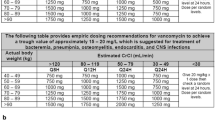Abstract
There have historically been concerns of acute kidney injury (AKI) with the use of aminoglycosides. The present study aimed to compare the AKI incidence and mortality rate between critically ill patients treated with aminoglycoside or meropenem in the intensive care unit setting using a propensity score matching approach. This cross-sectional study was conducted at two university hospitals from January 2011 to October 2017. Clinical and laboratorial data were evaluated to exclude potential confounders and to calculate the Charlson index. AKI was classified according to the Acute Kidney Injury Network criteria. All tests were two-tailed, and a p value ≤ 0.05 was considered significant in the univariate and multivariate analyses. We included 494 patients, 95 and 399 of whom used meropenem and aminoglycoside, respectively. Patients in the subgroup that used meropenem were matched with controls (aminoglycoside). Among the 494 patients, 120 developed any grade of AKI (24.2%). After propensity score matching, there were no significant differences in AKI incidence and mortality rate between the aminoglycoside and meropenem groups (p = 0.324 and 0.464, respectively). Patients on the aminoglycoside regimen neither presented a higher AKI incidence nor mortality rate when compared with those on the meropenem regimen. Aminoglycosides may be a safe option for the treatment of critically ill patients on carbapenem sparing antimicrobial stewardship programs.
Similar content being viewed by others
References
Tuon FF, Aragao BZ, Santos TA, Gasparetto J, Cordova K, Abujamra M (2016) Acute kidney injury in patients using amikacin in an era of carbapenem-resistant bacteria. Infect Dis (Lond) 48(11–12):3
Peixoto BC, Contrera GG, Cieslinski J, Gasparetto J, Tuon FF (2018) Acute kidney injury in patients using low dose (3 mg/kg/day) of gentamicin under therapeutic dose monitoring. The Journal of infection 76(5):496–498
Nicolau DP, Freeman CD, Belliveau PP, Nightingale CH, Ross JW, Quintiliani R (1995) Experience with a once-daily aminoglycoside program administered to 2,184 adult patients. Antimicrob Agents Chemother 39(3):650–655
Bagshaw SM, George C, Bellomo R, Committe ADM (2008) A comparison of the RIFLE and AKIN criteria for acute kidney injury in critically ill patients. Nephrol Dial Transplant 23(5):1569–1574
Tuon FF, Rigatto MH, Lopes CK, Kamei LK, Rocha JL, Zavascki AP (2014) Risk factors for acute kidney injury in patients treated with polymyxin B or colistin methanesulfonate sodium. Int J Antimicrob Agents 43(4):349–352
Gerlach AT, Stawicki SP, Cook CH, Murphy C (2011) Risk factors for aminoglycoside-associated nephrotoxicity in surgical intensive care unit patients. Int J Crit Illn Inj Sci 1(1):17–21
Oliveira JF, Silva CA, Barbieri CD, Oliveira GM, Zanetta DM, Burdmann EA (2009) Prevalence and risk factors for aminoglycoside nephrotoxicity in intensive care units. Antimicrob Agents Chemother 53(7):2887–2891
Roger C, Nucci B, Molinari N et al (2015) Standard dosing of amikacin and gentamicin in critically ill patients results in variable and subtherapeutic concentrations. Int J Antimicrob Agents 46(1):21–27
Duszynska W, Taccone FS, Hurkacz M, Kowalska-Krochmal B, Wiela-Hojenska A, Kubler A (2013) Therapeutic drug monitoring of amikacin in septic patients. Critical care (London, England) 17(4):R165
Goodlet KJ, Benhalima FZ, Nailor MD. A systematic review of single-dose minoglycoside therapy for urinary tract infection: is it time to resurrect an old strategy? Antimicrobial agents and chemotherapy 2019; 63(1)
Valette X, du Cheyron D (2013) A critical appraisal of the accuracy of the RIFLE and AKIN classifications in defining "acute kidney insufficiency" in critically ill patients. J Crit Care 28(2):116–125
Dobrowolski L (2000) B Bd, Sadowski J. differential effect of frusemide on renal medullary and cortical blood flow in the anaesthetised rat. Exp Physiol 85(6):783–789
Dobrowolski L, Badzynska B, Grzelec-Mojzesowicz M, Sadowski J (2001) Renal vascular effects of frusemide in the rat: influence of salt loading and the role of angiotensin II. Exp Physiol 86(5):611–616
Silbert BI, Ho KM, Lipman J et al (2017) Does furosemide increase oxidative stress in acute kidney injury? Antioxid Redox Signal 26(5):221–226
Ng KP, Chanouzas D, Fallouh B, Baharani J (2012) Short and long-term outcome of patients with severe acute kidney injury requiring renal replacement therapy. QJM : monthly journal of the Association of Physicians 105(1):33–39
Bedford M, Stevens PE, Wheeler TW, Farmer CK (2014) What is the real impact of acute kidney injury? BMC Nephrol 15:95
Acknowledgments
We thank the ICU staff of our hospitals for assistance.
Funding
Felipe Tuon is a CNPQ researcher.
Author information
Authors and Affiliations
Corresponding author
Ethics declarations
Conflict of interest
The authors declare that they have no conflict of interest.
Ethical approval
Yes
Informed consent
None.
Additional information
Publisher’s note
Springer Nature remains neutral with regard to jurisdictional claims in published maps and institutional affiliations.
Electronic supplementary material
ESM 1
(XLSX 255 kb)
Rights and permissions
About this article
Cite this article
Pitta, R.D., Gasparetto, J., De Moraes, T.P. et al. Antimicrobial therapy with aminoglycoside or meropenem in the intensive care unit for hospital associated infections and risk factors for acute kidney injury. Eur J Clin Microbiol Infect Dis 39, 723–728 (2020). https://doi.org/10.1007/s10096-019-03779-6
Received:
Accepted:
Published:
Issue Date:
DOI: https://doi.org/10.1007/s10096-019-03779-6




